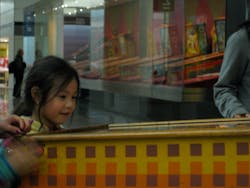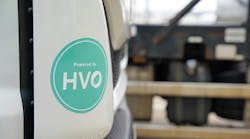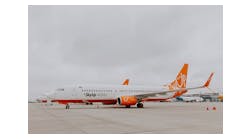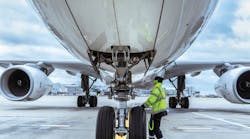Airports across the country are using art as another way to create a sense of place. The effort gives passengers the chance to see exhibits they might not otherwise see and it allows airports to showcase local artists on walls that otherwise would be blank.
Laura Lott is president and CEO of Washington, D.C.-based American Alliance of Museums (AAM). “Airports serve as some of the most important gateways to communities of all sizes. There is no better way to introduce a visitor to a region’s people, history and culture than through visual arts,” she noted. “Many cities and regions have made the arts part of their brand, and that branding starts in the airport.”
Traveling by air is an amazing experience, but air travel also causes anxiety and stress for many travelers, said Lott. “Art has an amazing ability to quickly soothe frayed nerves. A contemplative moment with a piece of art has a wonderful calming effect. We're just starting to understand the neuroscience of this effect, but few argue the existence of this attribute,” she said.
San Francisco International has the distinction of becoming the first airport museum — SFO Museum — to receive accreditation from AAM, in 1999. “Receiving accreditation from AAM was an important milestone for SFO Museum, providing peer-based validation that we operate with best museum practices,” said Tim O’Brien, the airport’s assistant director of exhibitions. “AAM accreditation also serves to enhance partnership opportunities with other accredited museums and lending institutions and allows our staff to avail themselves of AAM publications and training.”
SFO Museum’s curatorial committee includes the museum’s director/chief curator and seven curators who develop 44 to 46 exhibitions each year, said O’Brien. “With 25 unique sites located throughout the terminals, we work to provide a balance of appealing exhibitions on the topics of history, design, decorative arts, popular culture, technology, craft and anthropology, among many others.”
The most successful exhibitions are those that explore the fascinating intersections between subjects, O’Brien explained. “Naturally, transportation is a frequent theme, with exhibitions on the subject of commercial aviation presented in five galleries located in the Aviation Museum and Library,” he said. “In programming such a broad range of subjects, we’re confident that we’re engaging and inspiring a great number of the airport’s 58 million annual passengers at any given time.”
Augusta Regional Airport’s art program highlights the art community in the Central Savannah River Area (CSRA), said Lauren Smith, the airport’s public relations and customer service manager. “There are numerous local artists who want to have a place in which they can highlight their work. What better place than the local airport,” she said.
The airport formed an art committee made up of aviation commissioners, airport staff and local art experts, said Smith. “When we want to hold an exhibit, we put out an artist all call and the committee then evaluates each one,” she explained.
There is no formal process to contacting and choosing artists, since this is a volunteer committee, said Smith. “Airport staff reaches out to those who we think may be interested and would be an asset to the program,” she said. “We normally put out three artists all calls for our Spring Music Fest and holiday entertainment, along with 2D/3D artists.”
For many visitors, Vancouver International Airport provides the first and last impression of British Columbia, said Rita Beiks, curator of the airport’s art program. “A lot of emphasis is placed on ensuring the art and architecture is reflective of the province’s diverse landscape and people. Vancouver’s award-winning Sense of Place draws on the themes of land, sea and sky,” she said.
The Vancouver Airport Authority’s thematic master plan sets the overall thematic design for all future planning and development at the airport, said Beiks. “The purpose is to celebrate the natural beauty and the cultural heritage of B.C. while recalling the memories of significant local community icons and experiences,” she explained. “Based on B.C.’s Land, Sea and Sky, each area within the airport reflects a specific geographic region.”
There are two components to Vancouver’s art program—permanent installations and temporary displays. The largest collection of art is made up of permanent installations, said Beiks.
“The majority of these pieces are created by British Columbian First Nations artists. When a construction project is underway in a public area, a percentage of the budget is put towards commissioning an artwork for that area,” said Beiks. “A selection committee reviews the submissions and selects one artist to create an artwork for permanent installation. These installations are located throughout the airport: departures, arrivals, pre-security, post-security, including inside and outside the terminal buildings.”
Vancouver International Airport also has more than 80 cases that showcase temporary art displays, said Beiks. “These museum-quality cases are situated throughout the various departures gates and corridors post-security. This artwork is typically on loan to the airport for between 12 and 18 months from a variety of independent artists and galleries from across the B.C.,” she said.
Anyone can submit their work for display, said Beiks. “A wide variety of artwork is displayed, including painting, photography, printmaking, furniture design, sculpture, costume design, ceramics, fashion design, industrial design, film, video, animation and children’s book illustration,” she noted. “The displays are installed and move semi-annually to different locations around Vancouver to provide repeat travelers with a changing display.”
SFO Museum has a staff of 36 full-time employees, while Augusta regional has just Smith and the art committee. Vancouver International has Beiks. Her company, Emily Goes Commercial Art Consultants, has a staff of four that work on the program part time.
AAM’s Lott has advice for airports looking to start an art program. “Think first about local partnerships. A local museum or arts commission can be a great resource,” she stated. “Airports and museums have a shared mission to serve the public and communities.”
U.S. museums preserve and protect more than a billion objects and help communities better understand and appreciate cultural diversity, said Lott. “Most museums are looking for opportunities to exhibit and program spaces beyond their four walls to reach new communities and audiences.”





